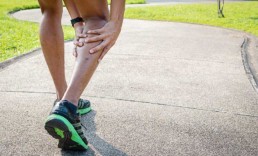The area of the leg behind the knee that reaches to the ankle is called the calf, deriving from the Old Norse word, kalfi, which referred to muscles in the lower leg.
In any case, our calves comprise two major muscles: the soleus and the gastrocnemius. The gastrocnemius is the large, diamond-shaped muscles that gives our lower legs their bulge. The soleus muscle is a flat muscle that lies beneath the gastrocnemius. They taper and merge with our Achilles tendon, which inserts into our heel bone. They are responsible for the downward motion of our foot. The calf muscles pull the heel up to allow for forward motion.
Calf Strain Symptoms
The most common injury to our calf muscle is a calf strain, which is also called a pulled calf muscle and a calf muscle tear. In actuality, the two conditions refer to different degrees of the same problem. They result from overstretching the muscle and tearing some or all of the fibres. The difference is in severity.
The most severe injury is a rupture, in which the muscle is completely torn away from the bone. The least severe is a Grade 1 strain. Strains can be cumulative, resulting from injuries over time, or instantaneous, occurring as the result of a particular movement or injury.
With a Grade 1 calf strain, the muscle is partially stretched; a few fibres may be torn. The muscle may feel tender or painful, but your motion isn’t impaired and you can walk normally.
A Grade 2 calf strain is a moderate injury with more stretching and more muscle fibres torn. You may feel a snapping or pulling sensation when the tears occur and you’ll probably feel tenderness and some pain. You’ll find a loss of strength in the calf and may find yourself limping as you walk.
A Grade 3 calf strain is a severe tear of your muscle fibres; it may even be torn all the way through. This is called a rupture and the muscle itself may collapse or roll up into a ball that can be seen under the skin. You should feel extreme pain and won’t be able to walk.
Calf strains mean injured muscles and disrupted cells, leading to bleeding and bruising under the skin. Bruising may extend down the leg toward the ankle as gravity forces some of the blood lower. There will likely be swelling in the area and the muscles may feel tight.

Common Causes for a Calf Muscle Injury
Often, a calf muscle injury occurs during a sporting activity when you push off on your foot quickly to achieve a burst of speed. Athletes in sports such as tennis, baseball, soccer and track are often subject to strains, as are gymnasts and dancers.
In general, calf muscle injuries are caused by sudden or forceful, uncontrolled movement, and can occur instantly – an acute injury – or over time – an overuse injury. As we age, our calves become more vulnerable to injury.
Calf Strain Treatment
When a calf strain first occurs, take care of it during the first 24 hours by adopting the RICE method: Rest, Ice, Compression and Elevation. This includes resting on your couch, elevating your injured leg, icing it every two hours for about 20 minutes and wrapping it tightly in an elastic bandage. If you must walk, heel lifts in your shoes are recommended.
For Grade 2 or 3 strains, you’ll probably want to see your physician for an accurate diagnosis. A Grade 3 strain may require surgery to repair the tear, and you may need to undergo an MRI (magnetic resonance imaging), a CT (computed tomography) scan or a calf muscle ultrasound to confirm the diagnosis.
For Grade 1 and 2 strains, your physician will probably suggest a course of physiotherapy to help you rehabilitate your injured calf. Your physiotherapist will design a course of treatment that will encompass minimizing pain, improving motion and strength and minimizing recovery time. To minimize pain, a combination of hands-massage, ultrasound, electricity and taping may come into play.
Initially, your physiotherapist may gently manipulate your calf to allow gentle motion; you’ll progress to exercises and stretches. You’ll also start to do strengthening exercises, possibly employing weights or machines to work your calf appropriately. Your physiotherapist will work with you to achieve your goals of returning to activity and participating in the sports you love.
Any injury takes time to rehabilitate, so the best strategy is to prevent it from occuring in the first place. Be sure to do warmup exercises before participating in a sport and follow a stretching and strengthening program during the off season. Wear shoes that fit properly and don’t increase the intensity of your activity too quickly. There are no guarantees that injuries won’t happen, but these measures will make it less likely.
